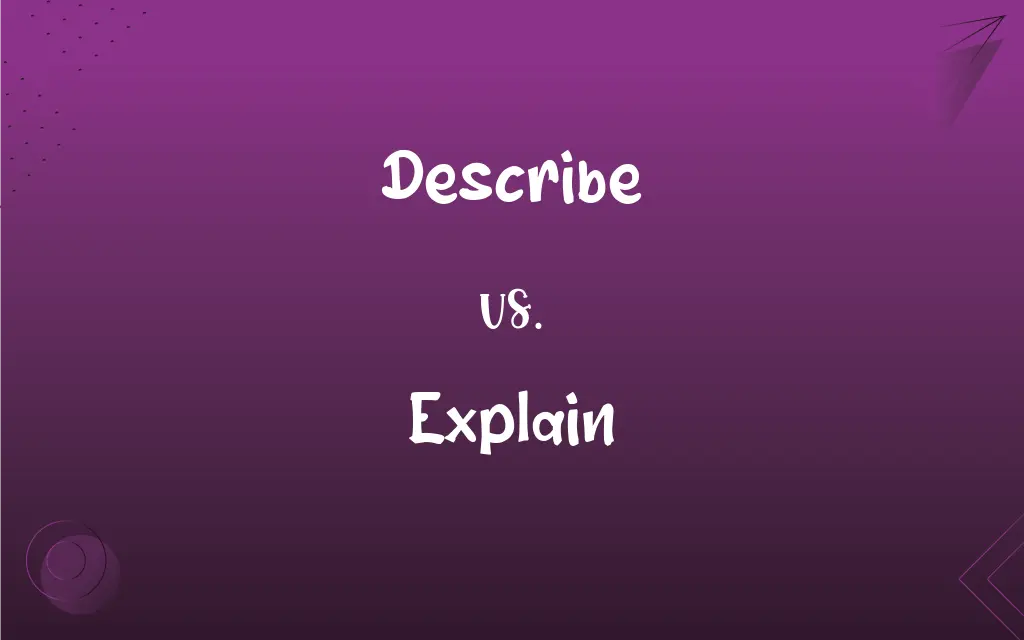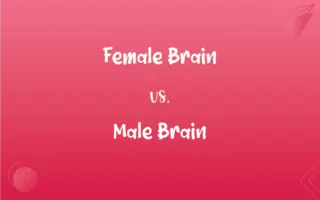Describe vs. Explain: What's the Difference?
Edited by Janet White || By Harlon Moss || Updated on October 6, 2023
Describe means to depict in words, while explain means to clarify or make clear.

Key Differences
Describe refers to portraying something verbally or in writing by detailing its features, characteristics, or specific events. Explain, on the other hand, goes beyond mere portrayal by providing reasons, clarifications, or insights to make something understandable.
In literature, an author might describe a setting by painting a vivid picture of its elements, like the lush greenery or the chirping of birds. If the same author were to explain a character's behavior, they'd delve deeper, providing insights into the character's past, motivation, or psyche.
When a person describes an object, they might talk about its color, shape, size, and other physical attributes. To explain that object’s function or purpose, one would need to provide information about how it works or why it was created.
If you were to describe a historical event, you might provide details about the event itself, such as the date, the people involved, and the outcome. But to explain that event, you'd provide context and delve into the causes and consequences, offering a more comprehensive understanding.
Similarly, in science, a researcher might describe an observed phenomenon, detailing its appearance or behavior. But to truly explain the phenomenon, the researcher would offer theories or evidence that sheds light on its causes or underlying principles.
ADVERTISEMENT
Comparison Chart
Purpose
To depict in words by detailing features.
To make clear or understandable by giving reasons.
Depth
Provides surface-level details.
Delves deeper into reasons, causes, or background.
Use in Literature
Portraying a setting or character's physical appearance.
Providing insights into a character's motivations.
In Academic Settings
Outlining a topic's elements or features.
Clarifying a topic's meaning or significance.
Result
Leaves reader with a vivid image or portrayal.
Leaves reader with a deeper understanding or clarity.
ADVERTISEMENT
Describe and Explain Definitions
Describe
To provide a detailed account or representation of something.
He described his journey through the dense forest.
Explain
To shed light on a situation or problem.
She explained the complications that arose during the project.
Describe
To trace the form or outline of.
Use the compass to describe a perfect circle.
Explain
To make clear or understandable.
Please explain your reasoning behind this decision.
Describe
To list the characteristics or features of a subject.
Can you describe the main characteristics of this species?
Explain
To define or interpret a word or concept.
Can you explain the concept of relativity to me?
Describe
To portray in words regarding appearance or attributes.
She described the painting as vibrant and lifelike.
Explain
To provide reasons for or a cause of.
He explained why he was late to the meeting.
Describe
To represent pictorially, often through words.
He described the scene in such detail I felt like I was there.
Explain
To provide a detailed account of a subject.
Let me explain the process of photosynthesis.
Describe
To give an account of in speech or writing
Describe a sea voyage.
Explain
To make plain or comprehensible.
Describe
To convey an idea or impression of; characterize
She described her childhood as a time of wonder and discovery.
Explain
To define; expound
We explained our plan to the committee.
Describe
To represent pictorially; depict
Goya's etchings describe the horrors of war in grotesque detail.
Explain
To offer reasons for or a cause of; justify
Explain an error.
FAQs
What does "describe" typically emphasize?
Describe emphasizes a portrayal or depiction of something in words.
Can "describe" relate to appearance only?
No, "describe" can relate to appearance, behavior, characteristics, and more.
How does "explain" differ from "describe"?
Explain delves deeper, offering reasons or clarifications, while describe focuses on portrayal.
When talking about a painting, which word would better detail its visual attributes?
"Describe" would be apt for detailing the painting's visual attributes.
Is "explain" always about providing reasons?
Not always. "Explain" can also mean to make clear, define, or interpret.
When detailing a setting in literature, which word is more apt?
"Describe" is more apt for detailing a setting's elements.
Is "describe" a surface-level detailing?
Generally, yes. Describe provides surface-level details, while explain goes deeper.
If I'm discussing the background or history of an artwork, which word should I choose?
"Explain" would be apt to discuss the background or reasons behind an artwork's creation.
If I want to clarify a complex scientific phenomenon, which word should I pick?
Use "explain" to provide clarity or deeper understanding.
In academic settings, when should I use "explain"?
Use "explain" to clarify a topic's meaning or significance.
Can "describe" be used in scientific contexts?
Yes, "describe" can be used to outline observations or phenomena in science.
What's the result of "describing"?
It leaves the reader with a vivid image or portrayal.
Can "explain" be used in casual contexts?
Yes, "explain" can be used casually to clarify or provide reasons.
Can "describe" and "explain" be used interchangeably?
Not always. While they can sometimes overlap, they have distinct purposes.
How would you "explain" a word's meaning?
To explain a word's meaning, you'd provide its definition or interpret its significance.
Which word would you use to give a detailed account of a topic?
Both can be used, but "describe" for detailing features and "explain" for understanding or reasons.
If I want to delve into a character's psyche in literature, which word should I use?
Use "explain" to delve into motivations or deeper insights.
What's the result of "explaining"?
It leaves the reader with a deeper understanding or clarity.
In academic settings, when should I use "describe"?
Use "describe" to outline a topic's elements or features.
Can you "describe" emotions?
Yes, you can describe emotions by detailing how they feel or manifest.
About Author
Written by
Harlon MossHarlon is a seasoned quality moderator and accomplished content writer for Difference Wiki. An alumnus of the prestigious University of California, he earned his degree in Computer Science. Leveraging his academic background, Harlon brings a meticulous and informed perspective to his work, ensuring content accuracy and excellence.
Edited by
Janet WhiteJanet White has been an esteemed writer and blogger for Difference Wiki. Holding a Master's degree in Science and Medical Journalism from the prestigious Boston University, she has consistently demonstrated her expertise and passion for her field. When she's not immersed in her work, Janet relishes her time exercising, delving into a good book, and cherishing moments with friends and family.































































